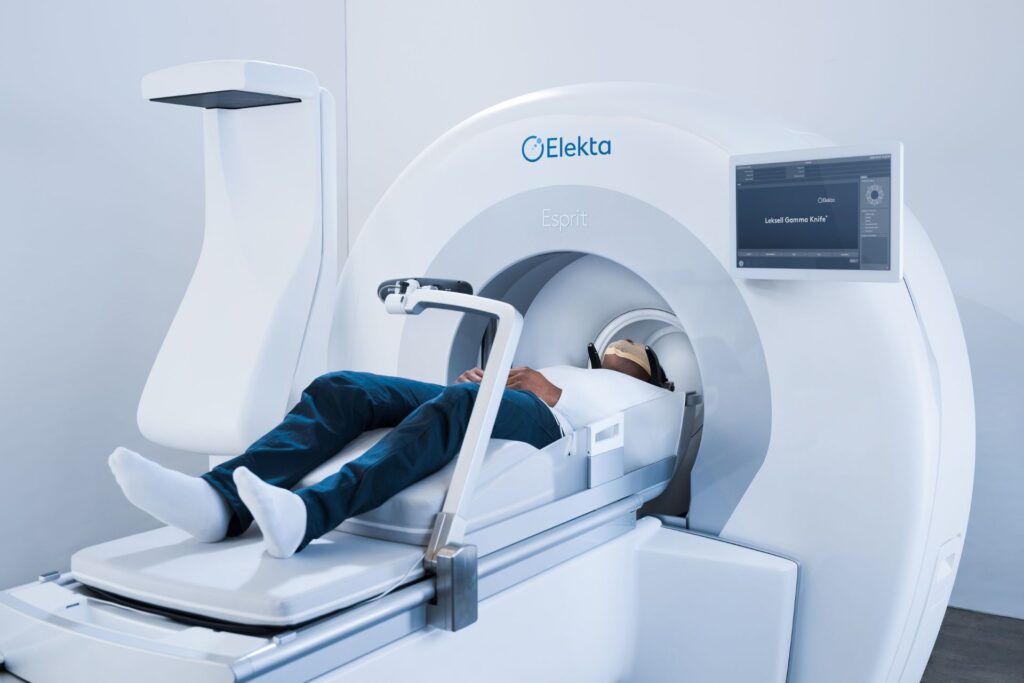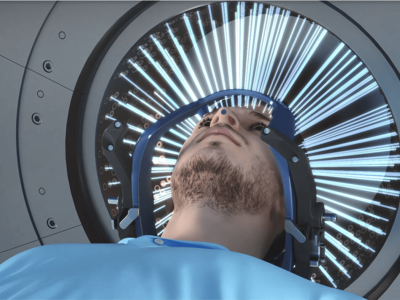Gamma Knife Radio-Surgery Cost in India

Gamma knife Radio Surgery
Contact Us
Frequently Asked Questions :
Is Gamma Knife Radiosurgery painful?
A1: No, the procedure is painless. Patients may feel slight discomfort from the positioning frame but are sedated during treatment.
How long does the treatment take?
A2: The actual Gamma Knife procedure typically takes between 30 minutes to two hours, depending on the complexity.
What are the side effects?
A3: Side effects are minimal but may include temporary swelling or fatigue. Long-term effects depend on the treated condition.
What is Gamma Knife surgery?
Gamma Knife is a non-invasive form of stereotactic radiosurgery that uses focused beams of radiation to treat brain tumors, vascular malformations, and functional brain disorders without a surgical incision.
Is Gamma Knife a real surgery?
No, it’s called “surgery” because of its precision, but there’s no cutting or anesthesia involved. It’s a painless outpatient procedure.
What conditions can be treated with Gamma Knife?
It’s used to treat brain tumors (both benign and malignant), arteriovenous malformations (AVMs), trigeminal neuralgia, acoustic neuromas, pituitary tumors, and some functional brain disorders like essential tremor.
Is Gamma Knife treatment safe?
Yes, it’s considered very safe with fewer risks compared to open brain surgery. It delivers radiation with sub-millimeter accuracy, minimizing damage to surrounding healthy tissue.
How long does a Gamma Knife procedure take?
The entire procedure usually takes between 1 to 2 hours, depending on the complexity and number of lesions being treated.
How soon will I see results of Gamma Knife treatment?
Results can vary. Some conditions like trigeminal neuralgia may show improvement within days, while tumors or AVMs may take several weeks or months to shrink or resolve.
How many Gamma Knife treatments sessions are needed?
In most cases, only one session is needed. Rarely, additional treatments may be required based on the condition’s response.
Is Gamma Knife available in India?
Yes, it is avalable in Fortis Memorial research Institute. The latest machiene GammaKnife Sprit.

About Gamma Knife Radiosurgery
Gamma Knife Radiosurgery is a non-invasive treatment method used primarily to target brain tumors, arteriovenous malformations (AVMs), and certain neurological disorders. Utilizing high doses of focused radiation, this advanced technology minimizes damage to surrounding healthy tissue while effectively destroying targeted cells. Dr. Sandeep Vaishya, a renowned neurosurgeon, specializes in this innovative treatment, offering patients a safer alternative to traditional surgery.
Causes of Conditions Treated with Gamma Knife
Gamma Knife Radiosurgery is commonly used to treat various conditions, including:
- Brain Tumors:
- Meningiomas
- Acoustic neuromas (vestibular schwannomas)
- Pituitary adenomas
- Metastatic brain tumors (cancer that spread to the brain from elsewhere)
- Gliomas (in some cases)
- Vascular Disorders:
- Arteriovenous malformations (AVMs) – abnormal tangles of blood vessels in the brain
- Cavernous malformations – clusters of abnormal blood vessels
- Functional Brain Disorders:
- Trigeminal neuralgia – severe facial pain; Gamma Knife can target the trigeminal nerve to relieve symptoms
- Movement disorders (such as essential tremor and Parkinson’s disease symptoms, in selected cases)
- Meningiomas: Tumors that form on the protective layers of the brain.
- Acoustic Neuromas: Benign tumors affecting the auditory nerve.
Understanding these conditions is crucial for patients considering treatment options.
Types of Gamma Knife Radiosurgery
There are several types of Gamma Knife procedures tailored to specific conditions:
- Stereotactic Radiosurgery (SRS): A single-session treatment delivering a high dose of radiation.
- Stereotactic Radiotherapy (SRT): Involves multiple sessions to target larger tumors.
- Fractionated Stereotactic Radiosurgery: Spreads the treatment over several sessions to minimize side effects.
Each type is designed to suit the patient’s unique needs, ensuring the best possible outcomes.

Symptoms Indicating the Need for Gamma Knife Treatment
Patients may experience various symptoms that warrant consideration for Gamma Knife treatment, including:
- Persistent headaches
- Seizures
- Vision problems
- Hearing loss or tinnitus
- Neurological deficits
If you experience any of these symptoms, it is crucial to consult with a healthcare professional for evaluation and potential imaging studies.
Diagnosis: How is Gamma Knife Treatment Decided?
Diagnosis typically involves:
- Neurological Examination: Assessment of symptoms and neurological function.
- Imaging Tests: MRI or CT scans to visualize the brain and identify abnormalities.
- Consultation: Discussing the diagnosis and treatment options with Dr. Sandeep Vaishya, who will recommend the most suitable approach.
A thorough diagnosis is essential for determining the appropriateness of Gamma Knife Radiosurgery.
Treatment Process: What to Expect
The treatment process involves several key steps:
- Consultation: Initial meeting with Dr. Vaishya to discuss symptoms, diagnosis, and treatment options.
- Preparation: Detailed imaging and treatment planning using advanced technology.
- Procedure: The non-invasive procedure typically lasts one hour, during which patients are comfortably positioned, and the Gamma Knife is precisely aimed at the target area.
- Recovery: Most patients can return home the same day, with minimal downtime.
Dr. Vaishya will provide specific post-treatment care instructions to ensure a smooth recovery.
Cost of Gamma Knife Treatment in India
The cost of Gamma Knife Radiosurgery in India can vary based on several factors, including the complexity of the case, the specific facility, and additional care required. On average, patients can expect treatment costs ranging from USD 7,000 to USD 8,000.